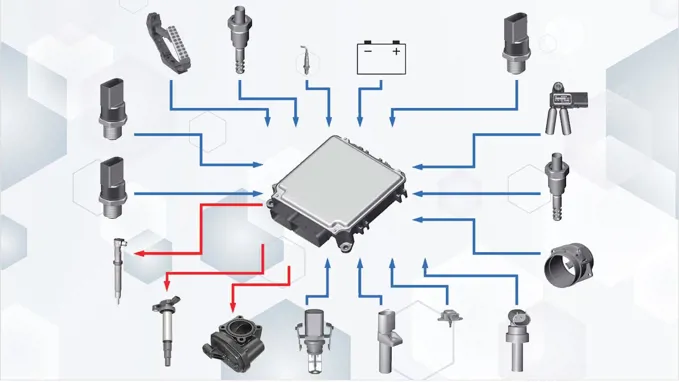What is an ECU?
The Engine Control Unit (ECU) is often referred to as the brain of a vehicle, managing crucial functions that directly impact performance, efficiency, and emissions control. When an ECU malfunctions, it can lead to a range of issues, from reduced engine performance to increased emissions and even complete vehicle failure. Repairing an ECU effectively is essential for maintaining a vehicle’s functionality and compliance with environmental standards. One powerful ECU Programming tool in this regard is Hexprog II, an advanced ECU Chip Tuning and repair solution. This article delves into the process of repairing ECUs using Hexprog II, detailing its features, benefits, and practical applications.
Understanding the Role of the ECU
Before exploring the repair process, it's essential to understand what an ECU does. The ECU controls various engine parameters, including fuel injection, ignition timing, air-fuel ratio, and emissions control. It receives input from numerous sensors throughout the vehicle, processes this data, and makes real-time adjustments to ensure optimal engine performance. When an ECU malfunctions, it can trigger Diagnostic Trouble Codes (DTCs), leading to reduced efficiency, poor engine performance, and potentially severe damage if not addressed.
The ECU can be effectively utilized for both Chip Tuning and ECU Programming, allowing automotive professionals and enthusiasts to unlock the full potential of their vehicles. By engaging in Chip Tuning, users can modify the ECU's software parameters to optimize performance, improve power delivery, and enhance fuel efficiency. Simultaneously, ECU Programming enables the precise adjustment of various vehicle settings and features, tailoring the driving experience to individual preferences. Together, these processes not only boost engine performance but also ensure that vehicles run more smoothly and responsively, maximizing overall driving enjoyment.
Common ECU Problems
ECUs can suffer from various issues, including:
- Faulty Sensors: Malfunctions in sensors like the Mass Airflow Sensor (MAF) or Oxygen Sensors can lead to incorrect readings and poor engine management.
- Corrupted Software: Sometimes, the ECU's software may become corrupted due to power surges or updates gone wrong, leading to operational issues.
- Wiring Issues: Damaged or shorted wiring can disrupt communication between the ECU and other components, leading to failure.
- Overheating: Excessive heat can damage ECU components, resulting in erratic behavior or complete failure.
- Environmental Damage: Exposure to moisture or contaminants can compromise the ECU's integrity.
How ECUs Operate
- Role of the ECU:
- The Engine Control Unit (ECU) is the "brain" of the engine, managing and optimizing performance.
- Data Collection:
- Receives input from various sensors:
- Mass Airflow Sensor (MAF): Measures air entering the engine.
- Throttle Position Sensor (TPS): Tracks throttle valve position.
- Oxygen Sensors (O2): Measures oxygen levels in exhaust gases.
- Coolant Temperature Sensor: Monitors engine temperature.
- Crankshaft and Camshaft Position Sensors: Controls timing.
- Receives input from various sensors:
- Data Processing:
- Continuously processes sensor data using complex algorithms and pre-programmed maps.
- Makes real-time adjustments for optimal engine operation.
- Utilizes adaptive learning to adjust based on driving conditions.
- Control Outputs:
- Sends commands to various engine systems:
- Fuel Injectors: Adjusts fuel timing and quantity.
- Ignition Coil: Manages ignition spark timing.
- Throttle Actuator: Controls air intake.
- EGR Valve: Manages exhaust gas recirculation.
- Sends commands to various engine systems:
- Monitoring and Diagnostics:
- Runs self-diagnostic tests to detect faults.
- Triggers diagnostic trouble codes (DTCs) for troubleshooting.
- Communication with Other Systems:
- Communicates with other control units (e.g., Transmission Control Unit, Anti-lock Braking System) via protocols like CAN.
- Ensures coordinated operation of various vehicle systems.
- Performance Optimization:
- ontinuously adjusts engine parameters to improve performance, fuel efficiency, and emissions compliance.
The ECU is crucial for ensuring that the engine operates optimally under varying conditions, enhancing vehicle reliability and drivability through real-time adjustments and diagnostics. By implementing Chip Tuning and ECU Programming, automotive professionals can fine-tune the engine's performance characteristics, allowing for greater power output, improved fuel efficiency, and a more responsive driving experience. These processes enable the ECU to adapt to different driving conditions and driver preferences, ensuring that the vehicle performs at its best while maintaining reliability and efficiency.
Precise Fuel Management: Optimizing Performance and Efficiency
In the automotive industry, precise fuel management is essential for maximizing engine performance, improving fuel efficiency, and reducing emissions. As vehicles become more sophisticated, the methods and technologies used to manage fuel have evolved, allowing for more accurate control over the air-fuel mixture during combustion. This article delves into the key components of precise fuel management, its importance, and the technologies driving this critical aspect of modern automotive engineering.
What is Precise Fuel Management?
Precise fuel management refers to the systematized control of fuel delivery to the engine based on real-time data from various sensors. The primary goal is to ensure the optimal air-fuel mixture for combustion, which affects engine performance, fuel consumption, and exhaust emissions.
Importance of Precise Fuel Management
- Improved Fuel Efficiency
- Efficient fuel management directly translates to better fuel economy. By optimizing the air-fuel mixture, vehicles can achieve more power with less fuel, ultimately reducing overall consumption and operating costs.
- Enhanced Performance
- A precisely managed fuel system ensures that the engine runs smoothly and responds quickly to driver inputs. This leads to better acceleration, higher power output, and a more enjoyable driving experience.
- Emission Control
- With stricter environmental regulations, precise fuel management is critical for reducing harmful emissions. By ensuring complete combustion of the fuel, vehicles can minimize pollutants released into the atmosphere, helping manufacturers comply with legal standards.
- Engine Longevity
- By preventing issues such as engine knock or improper combustion, precise fuel management contributes to the longevity of the engine. This reduces the likelihood of costly repairs and enhances overall vehicle reliability.
Perfecting Combustion in Modern Engines
Perfecting combustion is essential for achieving optimal engine performance, efficiency, and reduced emissions. The Engine Control Unit (ECU) plays a pivotal role in this process by managing various factors that influence how fuel burns in the engine.
At the heart of effective combustion is the air-fuel mixture. The ECU continuously adjusts this ratio to ensure complete combustion. An ideal mixture not only maximizes power output but also minimizes the presence of unburned fuel and harmful emissions. By precisely managing the amount of air and fuel entering the combustion chamber, the ECU helps create a more efficient burn, leading to improved engine performance.
Another critical aspect of combustion optimization is ignition timing. The ECU controls the timing of the spark plugs ignition, ensuring that the fuel-air mixture ignites at the optimal moment. This precise timing is crucial for achieving a powerful combustion event, which contributes to the engine's overall performance.
Hexprog II Chip Tuning and ECU Programming Tool: Advanced Online Services for ECU Optimization
Hexprog II is an advanced ECU Chip Tuning Tool and repair tool that provides a range of services for diagnosing and rectifying ECU issues. It features an intuitive interface, extensive vehicle model support, and powerful online services designed to optimize ECU performance. Key features include:
- DTC Removal: Easily clear Diagnostic Trouble Codes to restore functionality and performance.
- EGR Off: Disable the Exhaust Gas Recirculation system to improve engine efficiency and reduce carbon buildup.
- DPF Off: Turn off the Diesel Particulate Filter to prevent clogging and related issues.
- AdBlue Off: Disable the AdBlue system to eliminate complications associated with urea injection.
- Custom Tuning: Tailor ECU parameters to suit specific performance needs and driving conditions.
These services can be easily accessed through customer account at www.hexprog.com and are available at competitive prices, ensuring you get high-quality ECU solutions tailored to your needs.
The Repair Process with Hexprog II
Repairing an ECU using Hexprog II involves several systematic steps:
- Initial Diagnostics
- Connect diagnostic device to the vehicle’s OBD-II port using the appropriate interface.
- Launch the diagnostic device software and select the vehicle model.
- Perform an initial scan to retrieve existing DTCs and gather information about the ECU’s current state. This diagnostic phase is crucial for identifying the underlying issues
- Interpreting Diagnostic Trouble Codes
- Analyze the retrieved DTCs to understand which sensors or systems are malfunctioning.
- Cross-reference DTC descriptions with vehicle service manuals to gain insights into potential problems.
- Clearing DTCs
- If the DTCs are related to temporary faults (e.g., minor sensor errors), clear the codes from the files read from Hexprog II through online service. This step helps determine if the issue persists after resetting the ECU.
- Monitor the vehicle's performance after clearing the codes to see if the problem returns.
- Addressing Specific Issues
- For persistent DTCs, identify the affected components. If, for instance, a MAF sensor is faulty, inspect it for damage, clean it if necessary, or replace it.
- Utilize Hexprog II’s features, such as EGR Off or DPF Off, if these systems are contributing to performance issues. Disabling these functions can provide temporary relief while further repairs are made.
- Software Reprogramming
- If the ECU software is corrupted, write good file using Hexprog II or possible to make virtual read and write, depends on ECU. Select the appropriate software version compatible with the vehicle model.
- Follow the on-screen instructions to upload the new software. Ensure a stable power supply during this process to prevent interruptions.
- Testing and Calibration
- Once repairs and reprogramming are complete, conduct a series of tests to ensure all systems are functioning correctly.
- Use Hexprog II to perform calibration tasks, such as adjusting fuel maps or ignition timing, to optimize the engine's performance post-repair.
- Final Diagnostics
- Conduct a final scan using diagnostic device to check for any new DTCs. This step confirms that all repairs were successful and that the ECU is functioning optimally.
- Clear any remaining codes and ensure that the vehicle is ready for regular use.
Benefits of Using Hexprog II for ECU Repair
- User-Friendly Interface: Hexprog II offers an intuitive design that simplifies the repair process, making it accessible even for those with limited technical expertise.
- Comprehensive Vehicle Support: The tool supports a wide range of vehicle makes and models, allowing for versatile application in various automotive scenarios.
- Cost-Effective Solutions: By providing a range of repair and tuning options, Hexprog II can save users money compared to dealership services, making it an economical choice for automotive professionals and enthusiasts.
- Real-Time Adjustments: The ability to make real-time adjustments to ECU parameters enhances vehicle performance and can address issues immediately.
- Remote Assistance: Hexprog II’s online features allow users to access updates and support, facilitating continuous improvement in ECU management.
Hexprog II offers advanced capabilities in ECU Programming and Chip Tuning, making it an indispensable tool for automotive professionals and enthusiasts. With a user-friendly interface, users can effortlessly navigate the software to access a comprehensive range of functions tailored to various vehicle models. This versatility enables precise optimization of ECU performance, allowing for significant enhancements in power delivery, fuel efficiency, and overall vehicle responsiveness.
Moreover, Hexprog II excels in its ability to modify ECU maps, enabling fine-tuning of ignition timing, fuel mapping, and boost control for turbocharged engines. Its robust features also facilitate advanced diagnostics and real-time data monitoring, empowering users to make informed adjustments. Whether for performance upgrades or efficiency improvements, Hexprog II stands out as a premier solution for effective ECU Chip Tuning and ECU Programming in the automotive industry.
With regular updates and an active user community, Hexprog II stays at the forefront of ECU Programming technology, continuously expanding its features and capabilities. For those looking to unlock the full potential of their vehicles, Hexprog II is the ultimate tool for precision ECU Chip Tuning and advanced automotive optimization.




